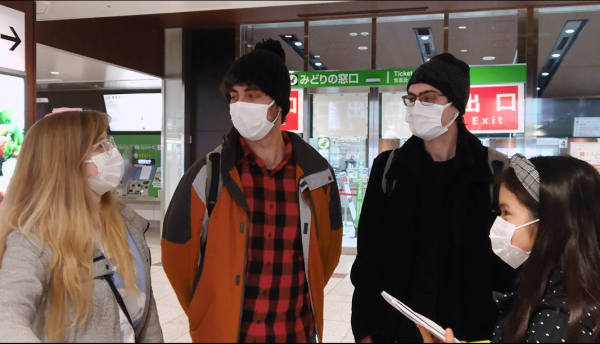KID REPORTERS’ NOTEBOOK
An Earthquake Strikes Japan

Nanaka interviews American teachers at the Sendai Station a day after the earthquake struck.
Shortly before midnight on February 13, a magnitude 7.3 earthquake struck northeastern Japan. The epicenter was just off the coast of the Fukishima and Miyagi prefectures, where I live. In 2011, the Great East Japan Earthquake devastated the area, leading to a tsunami and a meltdown at a nuclear power plant.
More than 140 people suffered minor injuries due to falling debris and shattered glass. Hundreds of thousands of homes temporarily lost power. “I was in a loft watching a video, and suddenly everything started to shake,” said 12-year-old Miori Araki. “It was a big shake, and I felt scared.”
The following day, I visited the Sendai Station, a major railway hub. Parts of the wall had been damaged, leaving debris on the floor. With operations suspended, a crowd of people had gathered at the ticket gate. I spoke with three Americans who work as English teachers in nearby areas. They were waiting to get back home.
“We were at a convenience store, and the ground started to shake,” one of the teachers said. “That was the biggest earthquake I’ve experienced, and it was pretty scary. We ran out of the store. I was shocked.”
At the Zuihōden Temple, a historic mausoleum complex in the Miyagi Prefecture, more than 100 stone lanterns and memorial towers near the entrance had collapsed.
The quake damaged stone lanterns and memorial structures at the historic Zuihōden Temple.
“ACT CALMLY”
Yuka Hasebe was at home with her two children when the quake struck. “I felt that I needed to protect my kids and keep the furniture from falling on us,” she said.
Due to disaster preparedness drills at school, the children knew not to go near the windows. They hid under a sturdy table and stayed safe. Hasabe recalled the deadly earthquake of 2011.
“I know what to do,” she said. “We slept in our clothes without changing into our pajamas so that we could evacuate quickly [in case of aftershocks]. It’s important to always be prepared because we never know when a disaster will happen.”
Japan is prone to earthquakes and volcanic eruptions because of its location along the Pacific Rim of Fire. According to the Japan Meteorological Agency, the February 13 tremblor was an aftershock of the 2011 quake.

Nanaka’s home suffered minor damage during the earthquake.
